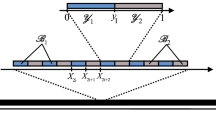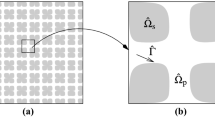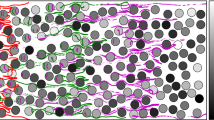Abstract
In the paper anomalous diffusion appearing in a porous medium composed of two porous components of considerably different diffusion characteristics is examined. The differences in diffusivities are supposed to result either from two medium types being present or from variations in pore size (double porosity media). The ‘long-tail’ effect is predicted using the homogenization approach based on the application of multiple scale asymptotic developments. It is shown that, if the ratio of effective diffusion coefficients of two porous media is of the order of magnitude smaller or equal O(ε 2), whereε is a homogenization parameter, then the macroscopic behaviour of the composite may be affected by the presence of ‘tail-effect’. The results of the theoretical analysis were applied to a problem of diffusion in a bilaminate composite. Analytical calculations were performed to show the presence of the ‘long-tail’ effect in two particular cases.
Similar content being viewed by others
Abbreviations
- c i :
-
the concentration of chemical species in water within the medium ‘i’
- D i :
-
the effective diffusion coefficient for the medium ‘i’
- D eff ij :
-
the macroscopic (or effective) diffusion tensor in the composite
- ERV :
-
the elementary representative volume
- h :
-
the thickness of the period
- l :
-
a chracteristic length of the ERV or the periodic cell
- L :
-
a characteristic macroscopic length
- n :
-
the volumetric fraction of the material 2
- 1−n :
-
the volumetric fraction of the material 1
- N :
-
the unit vector normal to γ
- t :
-
the time variable
- x :
-
the macroscopic (or slow) space variable
- y :
-
the microscopic (or fast) space variable
- c 1c ,C 2c ,D 1c ,D 2c :
-
the characteristic quantities
- T,T 1L ,T 2L ,T 1l ,T 2l :
-
the characteristic times
- c *1 ,c *2 ,D *1 ,D *2 ,t * :
-
the non-dimensional variables
- ε :
-
the homogenization parameter
- Ω1 :
-
the domain occupied by the material 1
- Ω2 :
-
the domain occupied by the material 2
- γ:
-
the interface between the domains 1 and 2
- ∥Ω∥:
-
the total volume of the periodic cell
- ∂/∂xi :
-
the gradient operator
- ∇:
-
the gradient operator
References
Arbogast, T., Douglas, J. R., and Hornung, U., 1990: Derivation of the double porosity model of single phase flow via homogenization theory,SIAM J. Math. Anal. (4), 823–836.
Auriault, J.-L., 1991: Heterogeneous medium, is an equivalent macroscopic description possible?Int. J. Engng. Sci. 29, 7, 785–795.
Auriault, J.-L., 1983: Effective macroscopic description for heat conduction in periodic composite,Int. J. Heat Mass Transfer 26(6), 861–869.
Auriault, J.-L., and Lewandowska, J., 1993: Homogenization analysis of diffusion and adsorption macrotransport in porous media: macrotransport in the absence of advection,Geotechnique XLIII(3), 457–469.
Auriault, J.-L., and Royer, P., 1993: Double conductivity media: a comparison between phenomeno-logical and homogenization approaches,Int. J. Heat Mass Transfer,36(10), 2613–2621.
Bensoussan, A., Lions, J. L., and Papanicolaou, G., 1987:Asymptotic Analysis for Periodic Structures, North-Holland, Amsterdam.
Brenner, H., 1980: Dispersion resulting from flow through spatially periodic porous media,Phil. Trans. R. Soc. Lond. A 297, 81–133.
Cala, M. A., and Greenkorn, R. A., 1986: Velocity effects on dispersion in porous media with a single heterogeneity,Water Resour. Res. 22(6), 919–926.
Charlaix, E. J., Hulin, P., and Plona, T. J., 1987: Experimental study of tracer dispersion in sintered glass porous materials of variable compaction,Phys. Fluids 30(6), 1690–1698.
Coats, K. H., and Smith, B. D., 1964.: Dead-end volume and dispersion in porous media,Soc. Petrol. Eng. J. 73–84.
Gillham, R. W., Robin, M. J. L., Dytynyszyn, D. J., and Jonston, H. M., 1984: Diffusion of nonreactive and reactive solutes through fine-grained barrier materials,Can. Geotech. J. 21, 541–550.
Gist, G. A., Thompson, A. H., Katz, A. J., and Higgins, R. J., 1990: Hydrodynamic dispersion and pore geometry in consolidated rock,Phys. Fluids A 2(9), 1533–1544.
Koch, D., and Brady, J. F., 1988: Anomalous diffusion in heterogeneous porous media,Phys. Fluids 31(5), 965–973.
Piquemal, J., 1992: On the modelling of miscible displacements in porous media with stagnant fluid,Transport in Porous Media 8, 243–262.
Sanchez-Palencia, E., 1980:Non-homogeneous Media and Vibration Theory, Lecture Notes in Phys. 127, Springer-Verlag, Berlin.
Sardin, M., Schweich, D., Leij, F. J., and van Genuchten, M. Th., 1991: Modeling the nonequilibrium transport of linearly interacting solutes in porous media: a review,Water Resour. Res. 27 (9), 2297–2307.
Spiegel, M. R., 1965:Theory and Problems of Laplace Transforms, Schaum Publishing Co., New York.
Author information
Authors and Affiliations
Rights and permissions
About this article
Cite this article
Auriault, J.L., Lewandowska, J. Non-gaussian diffusion modeling in composite porous media by homogenization: Tail effect. Transp Porous Med 21, 47–70 (1995). https://doi.org/10.1007/BF00615334
Received:
Revised:
Issue Date:
DOI: https://doi.org/10.1007/BF00615334




